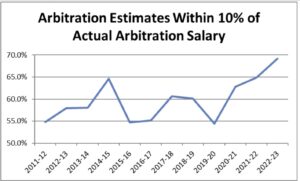Diamond Sports Group, the corporation which owns the Bally Sports networks responsible for local broadcasts of a number of MLB teams, forewent interest payments worth roughly $140MM to creditors last Wednesday (Associated Press link). The decision kicked off a 30-day window for Diamond to determine whether it is capable of meeting its debt obligations or is going to default on its commitments.
The missed payment came as no surprise, with various reports noting Diamond’s rough financial situation for months. Should the corporation default and potentially file for bankruptcy, it’d likely have a few options: honor its existing contractual commitments, withdraw from the deals, or attempt to renegotiate its contracts at more manageable rates. Diamond has separate broadcasting deals with all 14 MLB clubs* with which it has contracts; renegotiations, if things come to that, would be at a team-by-team level rather than in any kind of package deal.
There’s still plenty to be determined about the company’s next steps. Its precarious financial position places a great deal of uncertainty about the stability of local TV rights for the clubs that have contracts with Diamond, however. Commissioner Rob Manfred addressed the situation at last week’s owners meetings, noting that the league is exploring alternatives to make sure those teams don’t lose in-market broadcasting (link via Alden Gonzalez of ESPN).
“Obviously, our first choice would be that Diamond pay the clubs what they’re contractually obligated to pay them, but because I guess I’m a contingency planner by nature, we are prepared no matter what happens with respect to Diamond to make sure that games are available to fans in their local markets,” Manfred said. “We think it will be both linear in the traditional cable bundle and digitally on our own platforms, but that remains to be seen. … Our first hope is that Diamond figures out a way to pay the clubs and broadcast the games like they’re contractually obligated to do.”
The league makes most out-of-market games available to subscribers to its MLB TV package. However, clubs’ local broadcasting deals supersede the league platform, leading to blackouts of in-market games on MLB TV. Manfred broadly indicated a desire to eventually permit MLB TV consumers to purchase various broadcasts both within and out of market (via Hannah Keyser of Yahoo! Sports), though that certainly won’t happen on a league-wide level anytime soon.
MLB has already branched out into various streaming deals. The league agreed to contracts with Apple and NBC for broadcasting arrangements on those companies’ respective streaming services last year. It certainly wouldn’t be a surprise to see MLB negotiate similar deals with other platforms over coming seasons. Those contracts — paired with various postseason TV deals, including a new broadcasting contract with ESPN tied to the creation of the Wild Card round in the most recent CBA — highlight the kind of national revenue bases the league will certainly continue to explore outside the realm of local broadcasting. Nevertheless, the uncertainty with Diamond is sure to be an area of concern within the league office over the coming months.
Diamond first purchased various regional sports networks, which had been under the Fox Sports moniker, from Disney in 2019. The company reportedly took on roughly $8 billion in debt to facilitate that transaction. As Travis Sawchik of The Score explored last month, rates of cable ownership have dropped precipitously over the past couple years, contributing to Diamond’s revenues falling short of its expectations. Declining cable rates are generally expected to continue in the future given the ongoing rise of various streaming platforms.
Concerns about a potential default have raised questions about the player payrolls for the teams that rely on local broadcasting fees from Diamond. It’s still too early in the process for clubs to have a firm idea if/how Diamond’s situation will affect player spending, though it’s something those organizations are surely monitoring.
Cardinals’ chairman Bill DeWitt Jr. addressed the situation shortly before Diamond failed to make its February 15 interest payment, for instance. “It’s a concern and a fluid situation, there’s no question about it,” he said last week (link via Derrick Goold of the St. Louis Post-Dispatch). “Something is going to happen sooner rather than later. It’s a big part of our revenue stream. We have nice rights fees. The (RSN) model is at risk. We’re operating like, no, it’s going to stay, but the reality is there’s going to be change.”
The situation has led to concerns about the possibility of a lowered salary cap in both the NHL and NBA. Those leagues, which have player spending fixed to league revenues as part of their respective collective bargaining agreements, each have a number of clubs with broadcasting agreements with Diamond. MLB, of course, has no salary cap. The MLB Players Association has steadfastly resisted any hard limitations on team spending throughout past CBA negotiations.
Questions about a potential league push for a cap arose again over the weekend. MLB created an Economic Reform Committee, which the commissioner indicated was in response to both this ongoing local TV uncertainty and more longstanding concern about revenue disparities between franchises. There’s little chance of the MLBPA entertaining a cap during the next round of collective bargaining negotiations in 2026, however. That would’ve been true regardless of the status of local RSN contracts but seems apparent as ever in light of the questions facing those cap leagues.
* The Angels, Braves, Brewers, Cardinals, Diamondbacks, Guardians, Marlins, Padres, Rangers, Rays, Reds, Royals, Tigers, and Twins are all broadcast by Bally.

